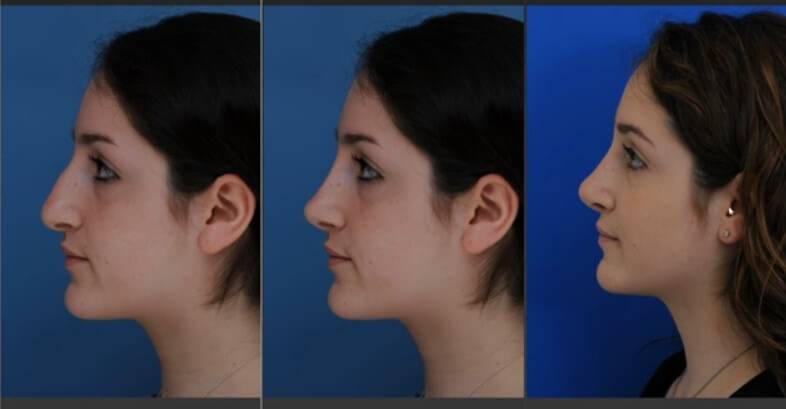Video: Using Photo Imaging Software For Rhinoplasty

Rhinoplasty is the most popular cosmetic surgery procedure in the United States, with 352,555 surgeries documented by the ASPS in 2020 (source). Learn more about how imaging technology is used to create amazing rhinoplasty results with this video by Dr. Minas Constantinides.
Video Transcription
This is Dr. Constantinides and today we’re going to show how photo imaging software helps create amazing rhinoplasty results.
This young lady wanted to have a smaller nose and a straighter bridge, without as much of a bump. She also wanted a little bit of a shorter nose. So we’re going to show how photo imaging can help give us an idea about the results rhinoplasty surgery can provide.
The first thing we are going to do is try to improve this bump. And the way we do that in surgery is to actually reduce the height of the bones and the top of the septum; which are the two things that usually create a bump. By reducing the bones up top and the height of the septum lower we can improve her profile look.
If we just did that change then her nose would just look too straight and too long, so we also want to try to create a little bit of a shorter look for her. That means the tip should be rotated up a little bit. This image manipulation is usually performed with the patient, so they can direct what kind of end result they want to achieve. Then we can try to show that through the imaging.
For example, while this patient was doing her imaging with me she determined that she wanted a tip that was quite a bit shorter and for her that meant a little bit more rotation. We want to make sure that the tip does not become too thin or narrow. After raising her tip the imaging results looked a little too narrow. So we will restore some of that roundness because that is what looks more natural.
At this point I would say to the patient, “Well, what do you think? Do you like that, or do you want to see a little bit more?” And we could play with bridge height if necessary.
She might say, “Well, that looks really pretty,” or she might say, “Well, what would it look like with the bridge a little bit lower?” The rhinoplasty imaging allows us to show how these changes will affect the patient’s overall final look.
The imaging also allows me to advise patients on changes that may not be surgically possible. So, for example, if this patient wanted to make her bump even lower I could advise her that I don’t think it’s possible, as the nasal bones would be unstable or the cartilage would create too much instability to give a good result long term.
Once we have created the final end result through the imaging software that the patient likes, we’ll save it. We can then compare it with the pre-imaged look side by side and say “Well, you know, does that look good to you or do you want to see a little bit more?” We can continue to play with the images as needed until we get it right.
In this case, I think the imaging accurately reflects a shorter appearance of the nose, while still having a natural look. Some patients might think this looks a little bit too sloped or upturned while others might think that that it looks just great. And that’s the wonderful thing about rhinoplasty imaging, it allows us to get a real clear sense about what a patient’s goals are, making my job as a surgeon much easier.
Here is her actual result after undergoing rhinoplasty surgery compared to her imaged result. You can see that her actual result is pretty close to what we created using the software. There might be a slight difference in terms tip size or orientation. But the overall rotation and bridge height changes look fairly comparable and we usually hit these within about a 5-10% error when we’ve compared.
Many patients think that their actual result looked better than their imaged result and I think in this case that’s true. She looks softer and more natural with her actual result.
So that’s photo imaging, we can actually look at the rest of her before and after pictures to show the actual surgical outcome to compare her oblique views. Straighter, better lines between brow and tip, very natural look, never over-done and stronger. She had airway problems. She couldn’t breathe through this nose and now she can breathe fine because we corrected her airway as well.
Thank you very much for listening!

Another thing anyone thinking about rhinoplasty can do is try a plastic surgery app to visualize what their results might look like. We just published an article on one of the best apps available here: https://www.newlooknow.com/blog/how-can-rhinoplasty-app-help-you-get-best-results
Thanks for sharing wonderful article!! Very helpful!!!